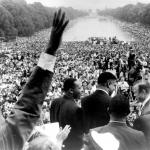Claiming and Teaching the 1963 March on Washington

August 28 will mark the 50th anniversary of the historic March on Washington for Jobs and Freedom. Publicly associated with Dr. King’s famous “I Have a Dream” speech, this march brought more than 250,000 people to the nation’s capital. The day went down in history as a powerful show of force against Jim Crow segregation. Over time this great event has risen to levels of near mythology. The powerful speech by Dr. King, replayed, in part, for us every January on Martin Luther King Day, has eclipsed all else—so much so that too many people believe that the March on Washington was entirely the work of Dr. King. It is also barely remembered that the March on Washington was for freedom and jobs.
In fact, The Americans, a high school history text by publishing giant Houghton Mifflin Harcourt, tells students that the march was called simply “to persuade Congress to pass the [1963 civil rights] bill.” In reality, the demand for jobs was not a throwaway line designed to get trade union support. Instead it reflected the growing economic crisis affecting black workers.
Indeed, while Dr. King was a major player, the March on Washington did not begin as a classic civil rights march and was not initiated by him. There is one constituency that can legitimately claim the legacy of the march—one that has been eclipsed in both history as well as in much of the lead-up to the August 2013 commemorations: black labor.
Initiated by A. Philip Randolph, president of the Brotherhood of Sleeping Car Porters, the march became a joint project with the Southern Christian Leadership Conference. Randolph and other black labor leaders, particularly those grouped around the Negro American Labor Council, were responding to the fact that the black worker was largely being ignored in the discussions about civil rights. In addition, the economic situation was becoming complicated terrain for black workers.
As historian Nancy MacLean has pointed out, the elements of what came to be known as deindustrialization—which was really part of a reorganization of global capitalism—were beginning to have an effect in the United States, even in 1963. As with most other disasters, it started with a particular and stark impact on black America.
It is also barely remembered that the Student Nonviolent Coordinating Committee played a key role in the event. The civil rights leadership insisted that the militant rhetoric of the original speech by SNCC’s then-chairman John Lewis—now Congressman John Lewis—be toned down. Reading U.S. history textbooks, students are seldom even introduced to the words of Lewis or other speakers. Here is Pearson’s U.S. history textbook coverage:
“Many people, including Christian and Jewish religious leaders, gave speeches that day, but none moved the crowd as did King. His voice rang as he proclaimed, ‘l have a dream that my four little children will one day live in a nation where they will not be judged by the color of their skins but the content of their character.’”
Teaching about the March on Washington presents a series of challenges precisely because it involves counteracting sanitized textbooks and demythologizing not only the march, but also the Black Freedom Struggle—the Civil Rights Movement, as it became known. As such, there are a few points that cannot be overlooked if we want to honor the march’s true story:
1. The context.
The idea for the march in 1963 did not appear out of nowhere, and the fact that A. Philip Randolph originated it was no accident. Read more here.
